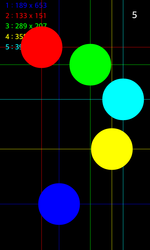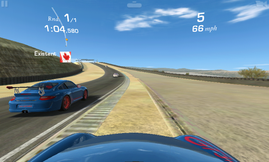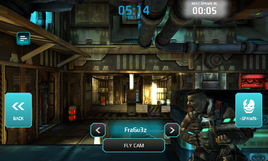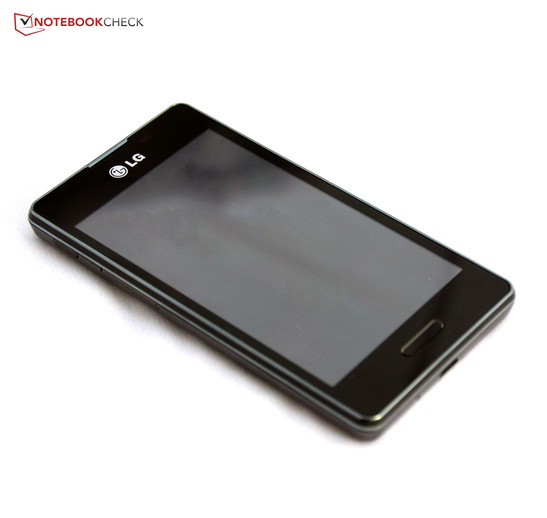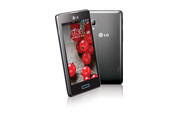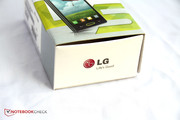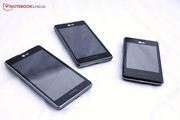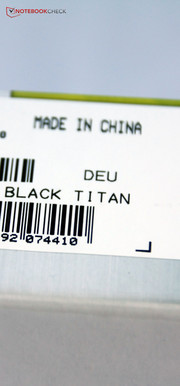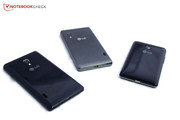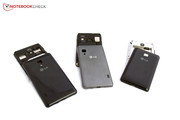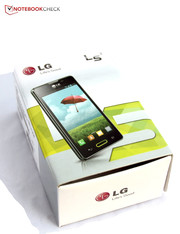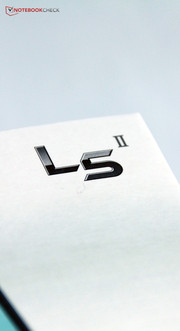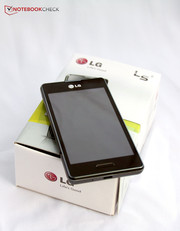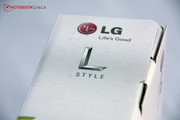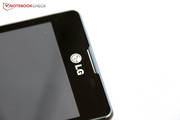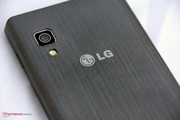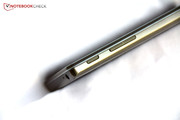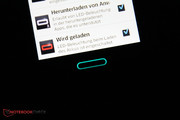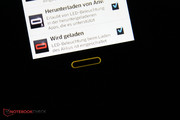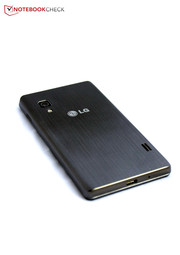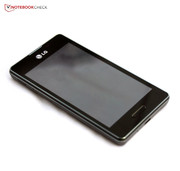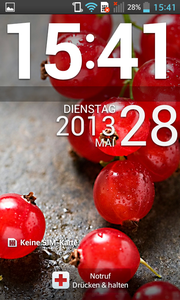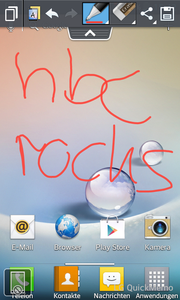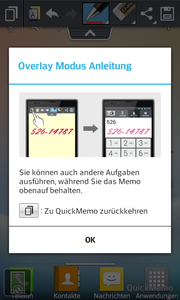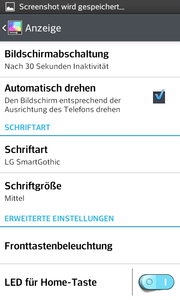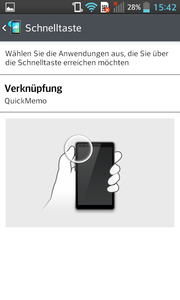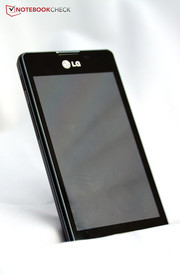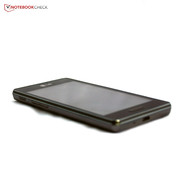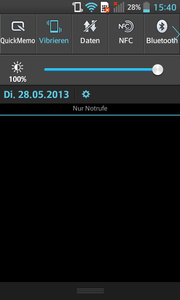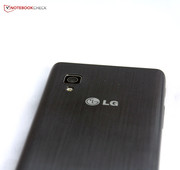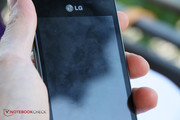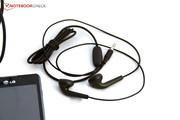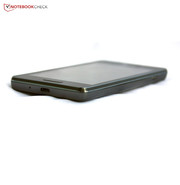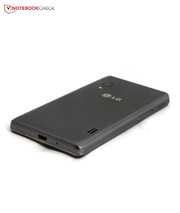Review LG E460 Optimus L5 II Smartphone

For the original German review, see here.
The designation already indicates it: The LG E460 Optimus L5 II is the second generation of LG's mainstream smartphone. The L5 has two siblings in this series: The LG Optimus L3 II and the Optimus L7 II; the 4.0-inch L5 is right in the middle in terms of size. According to LG the first generation of the three smartphones sold over 10 million units world-wide within 10 months - an impressive result and a challenge for the successor.
LG completely redesigned the case of the Optimus L5 II, noticeably increased the resolution of the display to 800x480 pixels, integrated a larger battery, reduced the weight by over 10 grams and integrated HSUPA for faster web browsing on the road.
The price of the LG Optimus L5 II is clearly below 200 Euros (~$263) and competes with the more inexpensive mainstream devices. For example, the Chinese Huawei Ascend Y300, which is even cheaper or the more price-confident Sony Xperia J. Or do you prefer a larger display? Then you could consider the Amoi N828, the Jiayu G3 or the Alcatel OneTouch Ultra, whereas the Samsung Galaxy Young is more compact. If you are willing to spend more money the Google Nexus 4 or the Samsung Galaxy Express are interesting alternatives; the latter even comes with LTE. It is a competitive environment for LG's new smartphones. We have a closer look at the LG Optimus L5 II and how it wants to stand out from the competition.
Case
The case of the predecessor was almost a designer piece with its color contrasts and the rounded edges; the LG Optimus L5 II seems quite simple by comparison. The only small highlights at the front are the trapezoidal speaker and the rounded "Home" button. This button can also be illuminated in different colors, for instance when the device is charging or when you get a call. The back of our review unit has a brushed aluminum look, white and black devices are also available. The buttons at the side are slightly roughened and can be easily felt.
The whole case is made of plastic, the back is quite catchy and does not attract fingerprints. The front is similarly catchy, which does not really favor the touchscreen operation; the front is also sensitive to fingerprints. The stability of the case is very good despite the fact that the whole back can be removed. It cannot be twisted and pressure on the back does not result in distortions on the touchscreen - very good.
LG managed to reduce the weight by 12 grams compared to the predecessor and the LG Optimus L5 II is even more compact in all dimensions despite the larger display. Compared to the rivals it is one of the lightest smartphones but leaves a high-quality impression and rests comfortably in the hand.
Connectivity
The majority of smartphones only have two ports: micro USB at the bottom and a stereo jack at the top. The LG Optimus L5 II is no exception, however, there is one additional button at the side. This button can be assigned according to your needs, for example open the notifications or trigger the camera.
Voice Quality
Calling with the LG Optimus L5 II is a pleasure: Both the caller and the recipient understand each other very clearly and with sufficient volume, the voice is very clear on both sides. However, voices sound a bit tinny when you use the built-in hands free feature.
Software
The LG Optimus L5 II comes with Android 4.1.2, not the latest version of Google's operating system but a very stable one. The operating system has been slightly adjusted by LG, which is evident on the home screen with the integrated emergency call feature and the menus that look different and include more features.
The Koreans did not include too much additional software: LG Smart World is a shop that shows apps from the Google Play Store and hardly provides any added value, you also need your own LG account. Quick Memo enables notes on the screen, you can write or paint and then save it as a picture. Safety Care offers several features to inform contacts when you are in an emergency situation.
Communication & GPS
NFC, Near Field Communication, was one of the advertised features of the first generation LG Optimus L5. By now it is mandatory and obviously integrated into the Optimus L5 II as well. Thanks to quad-band GSM you can also use the smartphone in almost all networks worldwide; dual-band UMTS, HSDPA and HSUPA provide fast internet. LTE is not available but there is also WLAN that supports the common standards. Transmitting power and reception of the device were good: With a distance of 10 meters and through two walls three out of four bars were indicated. Another wall and additional two meters between the device and the router reduced the reception to 50%.
A GPS module is integrated but it took some time to find the satellites and get a location, the accuracy was okay with 7 meters. The connection is not very stable indoors compared to other devices.
Cameras & Multimedia
LG only equips the Optimus L5 II with one camera at the back; it has a resolution of 5 megapixels and is supported by an LED flash. The camera has problems with bright areas; the picture loses details. They also appear too soft and colors are unnatural. The LED flash is used in dark environments but the auto focus does not always work properly and the pictures are overexposed. All in all, not the best camera performance.
Accessories
You should not expect too many accessories in the box of the LG Optimus L5 II, at least there is a headset and a Quick Start Guide besides the mandatory charger and data cable. Some manufacturers waive them nowadays.
Nevertheless, LG offers interesting accessories: for instance the mobile photo printer with special photo paper that does not require ink. You can send pictures with an app via NFC or Bluetooth to the printer and print them on the road. Unfortunately the printer is not yet available and there is no information about the quality. The price is around 200 Euros (~$263) but you will have to buy the special paper, which is not quite inexpensive.
Apart from that you can buy additional batteries and a Bluetooth headset that has a unique design - a collar with headphones you can put around your neck - not everybody will like that.
Warranty
The warranty period is 24 months for the device and 6 months for accessories like the battery, the charger and so on. Warranty cases are either handled directly by LG or the retailer where you bought the device. If LG repairs the device you will have to pay for the shipping. Attention: LG only offers the 24-month warranty for a maximum period of 27 months after the production date. If you get a device that was on the shelf for quite some time the actual warranty period might be shorter.
Input Devices & Handling
You can easily operate the touchscreen of the LG Optimus L5 II with the fingers, it reacts very precisely and accurately. It even recognizes inputs when we wear light gloves but you will most likely have to take them off in the winter. The display recognizes up to five fingers simultaneously, unfortunately the surface is quite sticky and produces an unpleasant resistance; it also attracts dirt and fingerprints.
LG improved the standard Android keyboard and replaced it with its own version, although it only differs in the color and some minor details. When you start the browser you get a keyboard that has been adjusted for web browsing. Sounds quite useful but the keyboard is a bit crowded and the space bar, admittedly not the most frequently used key during web browsing, is very small. If you do not like the LG version you can always use one from the Google Play Store since other keyboards are not preinstalled; you can try numerous keyboards in the store.
Display
The display is often a problem with inexpensive smartphones: Brightness and viewing angle stability are usually not convincing. The LG Optimus L5 II seems to be the praiseworthy exception: an average brightness of 416.1 cd/m², which is not reduced on battery and a reasonably even brightness distribution combined with an IPS display, which promises high viewing angle stability, speak for itself. The only drawback is the resolution: 800x480 pixels is just okay for a 4.0-inch display. However, we are spoiled by Full HD displays and the picture of the LG Optimus L5 II is subjectively not as sharp.
| |||||||||||||||||||||||||
Brightness Distribution: 86 %
Center on Battery: 435 cd/m²
Contrast: 777:1 (Black: 0.56 cd/m²)
ΔE Color 6.79 | 0.5-29.43 Ø5
ΔE Greyscale 7.35 | 0.57-98 Ø5.3
Gamma: 2.34
Contrast and black value are still okay but fall behind the competition. The high black value especially prevents a decent contrast despite the high brightness, the result is a gloomy picture.
Our color analysis with the colorimeter and the CalMAN software shows that the colors show a distinct red cast but the human eye can hardly see any deviations compared to the defined colors of the sRGB color space. Cyan and magenta show the biggest deviations; white colors are also quite inaccurate, this is also evident in the grayscale presentation. Additionally the colors are slightly oversaturated.
Although it is exhausting for the eyes the display content is still visible even under direct sunlight thanks to the high brightness. A better contrast ratio would certainly improve the visibility and streaks on the dirt sensitive display also have a negative effect. There are no problems in the shade or in bright indoor environments.
Performance
Our review unit is based on a one-chip system from MediaTek with the designation MT6575. The processor is a Cortex-A9 CPU with a clock of 1 GHz. The graphics chip is provided by PowerVR; the SGX531 also contains a processor and is clocked at 200 MHz. The SoC supports up to two SIM cards and an 8 megapixels camera but LG decided to save some money. 512 MB RAM and 4 GB flash storage are also not very generous.
The LG Optimus L5 II is always in the bottom of the charts when it comes to CPU and system performance and comparable to the Sony Xperia J and the Samsung Galaxy Young. Similarly priced smartphones from China, for example the Jiayu G3 or the Amoi N828, offer considerably more performance. Subjectively, the performance is not bad and we could not determine any delays navigating through the operating system; all the applications we tested ran smoothly.
| Smartbench 2012 - Productivity Index (sort by value) | |
| LG E460 Optimus L5 II | |
| Sony Xperia J | |
| Jiayu G3 | |
| Amoi N828 | |
| Huawei Ascend Y300 | |
| Samsung Galaxy Young DUOS GT-S6312 | |
| Samsung Galaxy Express GT-I8730 | |
| Google Nexus 4 | |
The graphics performance of the LG smartphone is better and it gets good mainstream results in almost all the benchmarks. Obviously it cannot compete with higher class devices like the Samsung Galaxy Express or the Google Nexus 4, but it is at least on the same level with the Alcatel OneTouch Ultra or the Huawei Ascend Y300. Most of the 3D applications or games should run smoothly.
| 3DMark - 1280x720 Ice Storm Standard Score (sort by value) | |
| LG E460 Optimus L5 II | |
| Samsung Galaxy Young DUOS GT-S6312 | |
| Samsung Galaxy Express GT-I8730 | |
| Google Nexus 4 | |
| GLBenchmark 2.5 | |
| Egypt HD Fixed Time (sort by value) | |
| LG E460 Optimus L5 II | |
| Samsung Galaxy Young DUOS GT-S6312 | |
| Samsung Galaxy Express GT-I8730 | |
| Google Nexus 4 | |
| 1920x1080 Egypt HD Offscreen Fixed Time (sort by value) | |
| LG E460 Optimus L5 II | |
| Google Nexus 4 | |
Browsing the web should be a pleasure with the Optimus L5 II, at least according to the specifications: The device is clearly ahead of its direct competitors and can even keep up with the Google Nexus 4. This impression was supported in our real world test: mobile internet is smooth and fast on the LG Optimus L5 II.
| Google V8 Ver. 7 - Google V8 Ver. 7 Score (sort by value) | |
| LG E460 Optimus L5 II | |
| Sony Xperia J | |
| Jiayu G3 | |
| Amoi N828 | |
| Huawei Ascend Y300 | |
| Alcatel OneTouch Ultra 997D | |
| Samsung Galaxy Young DUOS GT-S6312 | |
| Samsung Galaxy Express GT-I8730 | |
| Google Nexus 4 | |
| Octane V1 - Total Score (sort by value) | |
| LG E460 Optimus L5 II | |
| Sony Xperia J | |
| Jiayu G3 | |
| Amoi N828 | |
| Huawei Ascend Y300 | |
| Samsung Galaxy Young DUOS GT-S6312 | |
| Samsung Galaxy Express GT-I8730 | |
| Google Nexus 4 | |
| Sunspider - 0.9.1 Total Score (sort by value) | |
| LG E460 Optimus L5 II | |
| Sony Xperia J | |
| Jiayu G3 | |
| Amoi N828 | |
| Huawei Ascend Y300 | |
| Alcatel OneTouch Ultra 997D | |
| Samsung Galaxy Young DUOS GT-S6312 | |
| Google Nexus 4 | |
* ... smaller is better
Our review unit also shows a decent performance in regard to the 4 GB internal storage for data and applications. However, you can only use 1.4 GB, the rest is occupied by the Android operating system. You can expand the storage with up to 32 GB via micro SD card.
The performance in the synthetic AndroBench is very good and can beat the Samsung Galaxy Express in the random read test and the random write test but cannot keep up with the Google Nexus 4.
All in all, the LG Optimus L5 II does not have the fastest processor but can convince with a decent 3D performance and is able to handle most standard applications without problems.
Gaming
Despite the sticky touchscreen the LG Optimus L5 II is well suited for games. The inputs of the position sensor, for instance in racing games, are well executed without delays and the performance of the graphics chip is also sufficient for more demanding 3D games like Real Racing 3 or ShadowGun: Dead Zone. Storage capacity might the biggest problem: Iron Man 3, for example, occupies more than half of it with 800 MB and cannot even be started because the game has to load additional data and there is no more space left.
Temperature
The temperature development of the LG Optimus L5 II is modest and similar to the rivals: The maximum temperature is 36.6 °C at the front - the warming can be felt but is never uncomfortable. You also have to push the device for a longer period to reach this value. Otherwise the temperatures are around 30 °C so it is usually cool.
(+) The maximum temperature on the upper side is 36.6 °C / 98 F, compared to the average of 35 °C / 95 F, ranging from 21.9 to 56 °C for the class Smartphone.
(+) The bottom heats up to a maximum of 36.5 °C / 98 F, compared to the average of 33.8 °C / 93 F
(+) In idle usage, the average temperature for the upper side is 30.5 °C / 87 F, compared to the device average of 32.7 °C / 91 F.
Speaker
The mono speaker on the back sits behind two slots and the sound is mainly directed backwards. The sound is not muffled when the device lies on a table but it is quieter when you put it on a soft surface.
The speaker is primarily focused on high and medium tones. Some violins, for instance, are very loud while you can hardly hear any deeper tones. The maximum volume is remarkable but the sound lacks details on the highest setting, especially with orchestral music, and produces distortions. All in all, the speaker is decent but movie and music enthusiasts should favor external speakers or headphones.
Energy Management
Power Consumption
The energy consumption of the LG Optimus L5 II is pretty much average but the high maximum consumption values attract our attention: 1.8 Watts during idle and 3.5 Watts under load is more than some of the more powerful smartphones. The consumption during standby and when the device is turned off is excellent with 0.1 and 0.01 Watts respectively. The rival Jiayu G3 with its very high consumption values especially left a negative impression in this category.
| Off / Standby | |
| Idle | |
| Load |
|
Battery Runtime
The battery runtimes of the LG Optimus L5 II are not really overwhelming. The smartphone didn't even manage six hours in the more practical WLAN scenario. With continuous but not too demanding usage you should be able to get through the day. Although the battery is average with 1,700 mAh and 6.5 Wh most of the competitors have better battery runtimes.
Verdict
The LG Optimus L5 II meets the requirements of a mainstream smartphone: It does not really stand out in one category. Inside the pretty simple case is a SoC with a weak processor and limited memory equipment. The internal storage is just too small and the quality of the camera is tolerable at best. The touchscreen with the sticky surface attracts dirt, at least it does not affect the functionality.
Fortunately, the LG Optimus L5 II has some highlights: The display is very bright and has excellent viewing angles thanks to IPS technology but there is also a drawback: The black value and contrast could be better, it would certainly improve the picture quality. The adjustable button on the left side of the case is a nice feature and the voice quality convinces us; there is also NFC and fast HSUPA.
The smartphone is quite inconspicuous in the other categories: Battery runtimes, gaming performance, heat development and software are okay but nothing more. Overall, inconspicuous is perhaps the best adjective to describe the LG Optimus L5 II: You won't get any jealous looks and you won't have any problems either. The device has no critical drawbacks but if you are looking for something special you will have to continue your search.


 Deutsch
Deutsch English
English Español
Español Français
Français Italiano
Italiano Nederlands
Nederlands Polski
Polski Português
Português Русский
Русский Türkçe
Türkçe Svenska
Svenska Chinese
Chinese Magyar
Magyar





